Inhalt:
Why an Espace of all things? Or more precisely: why an Espace J63 of all things? A little advice on buying so that an adventure doesn’t turn into a terrible nightmare. First of all, I would like to briefly explain why, among the many offers of used vans (there are hardly any new ones left), it should be one from Renault. And why on earth should it be such an old Renault? Old Renaults don’t necessarily have a reputation for being particularly reliable.
But actually this is like a self-fulfilling prophecy, because very few Renaults are still maintained in their old age. Why should they? It’s „just a Renault“, it won’t last as long as the good German cars anyway.
Well, „long“ is relative in this day and age. The average vehicle in Germany is just over eight years old. Even the least well-maintained vehicles last that long. But the Espace J63 now has the status of a youngtimer. Even the youngest ones have long since counted their birthdays with a leading „2“.
Espace models
But first let’s clarify the terminology, who knows anything about the internal codes for the cars? W126, E36, 32BQP, these are codes that still mean something to German car enthusiasts. So here’s a brief overview of the different generations.
1. Generation
1984-1991, J11, fully galvanised steel chassis, GRP exterior, manufacturer: Matra
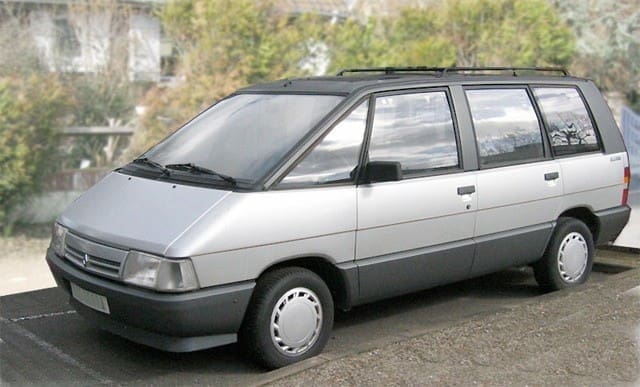
Picture under GNU-Licence
2. Generation
1991-1996, J63, fully galvanised steel chassis, GRP outer skin, manufacturer: Matra
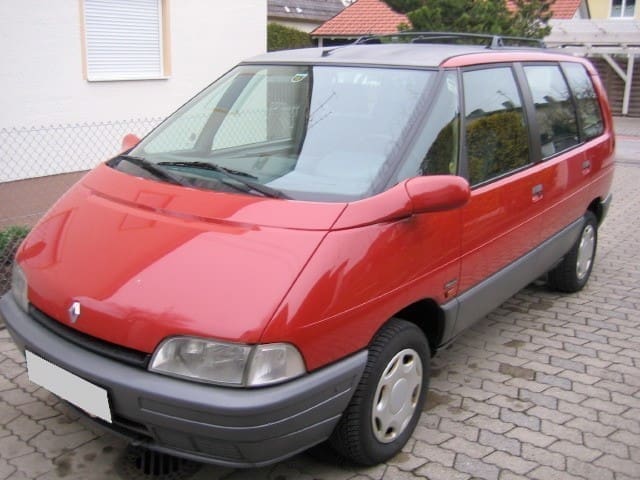
3. Generation
1996 – 2002: JE, fully galvanised steel chassis, GRP outer skin, manufacturer: Matra
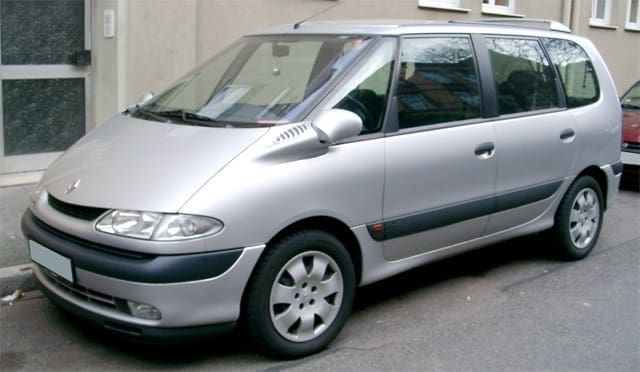
Picture under GNU-Licence
4. Generation
2002 – 2015 JK, classic steel construction, manufacturer: Renault

Picture under GNU-Licence
The Espace is dead! Long live the Espace!
This is the end of the line of ancestors. The fifth-generation „Espace“ (RFC), which appeared in 2015, is … well, what exactly? No Espace, that much is undoubtedly certain. Much smaller in external dimensions and narrower in the interior and more than 10 cm flatter than its predecessor, Espace connoisseurs are at a loss when confronted with the … er … car. If the overweight JK was already accused of breaking with tradition, it remains a mystery how an Espace nameplate could be attached to a lowered and flattened „SUV estate“ without any significant ground clearance. Be that as it may, I will not consider this vehicle any further here.
Identification
The vehicle registration document provides information about the vehicle in front of you: The chassis number also includes the manufacturer’s code.

J63 is the model, the 7 indicates the engine – in this case 2.2 litres.
Who notices the „mistake“ in the picture? Well?
Right: in 1997 the JE had already been on the market for half a year, so I bought a real slow seller. :)
The first-generation J11 is something for enthusiasts. Only the J63 offered minimal safety features such as airbags, seatbelt tensioners, all-round disc brakes and ABS. These features were only optional, but from the end of 1995 (with a reinforced front section) they became standard.

(Cockpit with airbag)
Value assessment
What can you do wrong when looking after an old Espace? Almost everything that is not good for a normal car is also bad for an Espace. Nevertheless, it shows real taker qualities. As a small example: Compared to the Shahambraxy (Sharan, Alhambra, Galaxy), the chassis is not derived from a small car, the Golf, so it turns out much more robust. Rust is also absolutely not an issue. Just look at the Kia Carnival I and II! Wow, they were actually rusting away in the showroom!
To cut a long story short: There’s no getting around the Espace if you want a car that’s good value for money. Sure, if you want to impress your neighbour – or even just to be taken seriously by the bourgeois – it would have to be a Sharan or Zafira bought on credit, but it’s my money I’m sinking into a vehicle. A new car like this loses the equivalent value of several good J637s if I just press one into the upholstery of the driver’s seat. Besides… in five years at the latest, the crap will start all over again, the successor model will come out and the neighbours will be looking again..
The great advantages of a classic Espace are as follows:
- Fully galvanised chassis
- GRP outer skin
- Manageable electronics
- Relatively low weight
- Robust engines (up to 1996)
- Inexpensive conversions to Euro3 and even up to D3
- Favourable used car prices
- Excellent space with small footprint
- Petrol engine with green sticker
The JE (1997 to 2002) still has the advantages of the robust body, but combines them with contemporary crash safety and transversely mounted engines. Since 1998 at the latest, however, extremely unpleasant electronic problems have been occurring more frequently. In addition, I personally find the price difference between the J63 and the JE in roughly comparable years of manufacture to be far too great; it is approximately a factor of 4-5 (as of 2007).
But let’s get to know the Espace better in general. It has an interesting story to tell:
History
The history of French carmakers in the 1970s is certainly as interesting as it is confusing. It would go beyond the scope of this article just to mention the various names given to the car manufacturers at that time – after all, this is really about the Espace. This one had several parents who got it off the ground, so we can’t avoid a little genealogy. Alas.
French-American friendship
At the time, Chrysler had a presence on the European continent through the purchase of Simca and held 50% of the shares of Matra, a low-volume manufacturer of sports cars and contract manufacturer for Chrysler/Simca. Matra, in turn, based on an idea by Philippe Guédon, the company’s technical director, developed a mixture of saloon, estate and bus, the P11, a prototype of the first Espace.
The new minivan was to take over the legacy of the Simca Rancho. This was an SUV-like leisure vehicle with room for up to seven people. So the Espace was actually first developed on the basis of Simca/Chrysler technology and was even more or less directly co-financed by Chrysler. The exciting thing about this is that they already had an equivalent vehicle in development in the form of the Voyager.
Peugeot as saviour?
In the summer of 1979, the PSA group (Peugeot/Citroën) took over the European business of the ailing Simca/Chrysler company and renamed it Talbot. Thus the 50% share in Matra also belonged to PSA. Peugeot, however, also had massive financial problems due to the takeover of the Chrysler plants, so they divested themselves of the Matra shares. The Groupe Lagardère, to which Matra originally belonged, took over Peugeot’s shares and thus once again became the sole shareholder of Matra.
Matra now had a minivan, but no buyer for it. The separation from PSA also meant the end of production of the Rancho in 1983. A precarious situation, because Peugeot saw no future in a vehicle like the Espace. The decision-makers could not place it in any category and so Matra peddled the concept. The small-series manufacturer lacked the funds and the distribution channels to launch the first European minivan on its own.
Misfortune in fortune
Fortunately, Renault showed interest in the P11, which was almost finished. In addition, production of the Talbot Rancho ended in 1983, freeing up production capacity. So what could be more obvious than a collaboration with Renault? Nothing, logical, right? But Matra entered into a momentous dependency.
They were not allowed to continue building their sports car Murena after Renault vetoed it; it was a competitor for the Renault Alpine. Matra swallowed this pill, after all, the order from Renault promised full order books and good sales – unlike the production of the Murena.
If it says Renault on it, it must be Renault in it. So before the Espace was ready for series production, it was largely converted from Simca/Chrysler to Renault technology. Mostly R18, R21 and R25 assemblies found their way from the parts shelf. The first „flawless“ Renault Espace was later the JE, in 1997.
In the J11 and J63 you can still find some components that were also used in Chrysler cars. Renault had got a bloody nose on the US market in the 1970s and since then had a cooperation agreement with Chrysler.
in 1990 Renault wanted to spoil the Chinese with French automotive engineering … er … and founded Sanjiang Renault Automobiles (SRAC) to distribute it. No, neither SsangYong, nor SangYang! The former is a Korean car manufacturer, the latter is a Taiwanese scooter manufacturer (SYM). In fact, the parts went like hot cakes. The R21 in particular sold convincingly. Renault supplied autopuzzels, i.e. the pure individual parts to China, which were assembled there. To cope with the flood of orders, Renault invested almost 100 million dollars in 1992 and built a plant with the capacity to produce one million vehicles per year.
Well, the connoisseur now wipes a tear of laughter from the corner of his eye and says: „Yeah, sure, that’ll go to shit! The Chinese also realise what Renault means by quality!“. In ten years (1994 to 2004), just 10,000 units were produced there, an average of 1,000 per year – one thousandth of the planned production. One thousandth! Renault doesn’t do things by halves, really.
In this way, however, the J63 was built as „Renault Univers“ in China even until 1999 – then they simply ran out of parts that could not be produced in China and had to be supplied by Matra. The JE was still produced in China as the „Renault Espace“ until 2004. By then, however, Matra was already history.
The end of Matra
So Renault became the sole client for Matra. A decision that in 2003, with the end of Renault Avantime production, also meant the end for Matra, a company rich in tradition. Although there were rumours that Matra was to produce a competitor for the Smart, nothing came of these plans.
At that time, the Espace JK had already been manufactured directly by Renault for a year. Needless to say, this Espace left the assembly line in conventional all-steel construction – with all its advantages and disadvantages.
The old Matras factory buildings were demolished, the warehouses with old Espace parts were scrapped or sold off. the design office sold to Pininfarina.
*DINGDONG*
Hello? Are you still alive? Terribly dull, isn’t it? Thank you for reading this far anyway. :-)
Unfortunately, I haven’t finished yet ;-)
Similarities
But let’s get back to the first two Espaces: the J11 and the J63. Both are – even though it’s hard to believe – actually the same car. They largely share the same technology and chassis. The J63 has a slightly rounder nose to accommodate a V6 engine and to keep the distance to the competition. But in principle, the J63 is based on the slightly modified and stiffened „frame“ of the J11.
Long-term protection
The first three generations of the Renault Espace were, as mentioned, developed by the Matra company. Matra had gained a lot of experience with sports cars based on a plastic-planked steel body, consequently the Espace was also designed in this rather unusual technique. Fortunately, the Matra people were not completely resistant to learning, so they thought that galvanising the chassis would not be a bad idea – after all, the super-flat sports cars invariably completely rotted through under the fancy plastic skin!
The advantages are obvious: the body, hot-dip galvanised at 450 degrees, but without the usual underbody protection, proves to be relatively resistant to rust. But this is not a licence not to take a closer look at the supporting steel frame. The rather casual work mentality of our neighbours west of the Rhine can be counterproductive when it comes to hot-dip galvanising.
Galvanising
But first a few words for a better understanding:
Hot-dip galvanising consists of several dipping baths of the finished car body. The surface of the steel must be completely and carefully cleaned of grease and other impurities and a flux applied before the zinc bath. In the case of the Espace, the body is immersed in a tank filled with around 350 tonnes of zinc until the steel has reached the temperature of the bath, which is 450 degrees Celsius after all.
During this process, the steel forms an alloy with the zinc, several layers of alloy are formed, which also solidify the molecular structure of the steel. The outermost layer consists of firmly adhering pure zinc. This layer is first shiny silver, later it turns dark grey and forms a crystalline-looking surface of zinc oxide.
Sources of errors during galvanising
Mistakes can now be made with the rinsing baths, which are supposed to wash out the acidic residues of the cleaning baths. If the residues of the acids are not completely removed, a rapid advance of the brown plague is to be expected. Since this usually only affects the cavities, this chassis may pass the final inspection without complaint.
If the steel in the dip bath does not reach the temperature of the zinc, fewer or no alloy layers will form. The layer of galvanisation is then less thick and cannot maintain its protective effect for long.
Another typical mistake is that the surface of the zinc bath is not removed. The lighter oxides float on this very surface and thus first adhere to the steel body before it touches the actual zinc bath during the immersion process. These residues are then located between the steel and the zinc and prevent the metals from alloying. Since no underbody protection was applied, you can work out what happens to an unprotected body after one winter at the latest.
So as an Espace owner, one should hope that Jean-Pascal has only smoked his breakfast Gauloises after running through his own car.
Fortunately, however, these are all exceptional occurrences, and such unprotected vehicles were soon to be ravaged by rust. However, one must bear in mind that such catastrophes cannot be betrayed by bubbles on the outer skin, as this is made of plastic.
The outer skin
The planked, partly glued outer parts of the body are made of glass-fibre reinforced polyester, which is immune to rust and minor damage, such as that caused by abandoned shopping trolleys in supermarket car parks.
The gap masses can only serve as a limited indicator of an accident. As mentioned before, these parts are glued and can thus be slightly offset on the chassis. This can partly conceal a distortion of the frame; on the other hand, uneven gap masses are not a clear sign of an accident.
Attention!
Never lift the vehicle by the sills! These are made of GRP! Inform independent workshops about this when carrying out repairs! If something does happen: Do not be put off and insist on the damage being repaired! The workshop must still know what it is doing.
The paintwork
J11 and J63 have been painted with two-component polyurethane paint.
However, the paintwork has the typical, sometimes extensive chipping of the clear lacquer, which Renault has only managed to get under control up to the JE. The bonnet of the JE is made of sheet metal not only for reasons of crash safety, but also to prevent the paint from chipping.
Like all red paints, Apache-Rouge has a tendency to fade. My red Espace, however, has neither chipped nor faded paint. Surely a success of… „lack of“ care.
The paint can be prevented from chipping by not polishing the car mechanically or by exposing the paint to large temperature fluctuations. Polishing makes the paintwork too hot in certain areas, and it is not only a truism that you should not drive a car into a car wash in frosty weather or in the blazing sun of July.
The bumper and roof were sprayed in the same paint, only in metallic grey (yes, it really is metallic!), but tiny polyester balls were added to the paint. This makes the paint very robust, but on the roof it unfortunately weathers very quickly due to the rough surface.
Apparently it is no longer possible to order this paint from Renault, as only the „main colour“ of the vehicles are listed in their data files. A Renault dealer said that the colour code could be found under the bonnet – if, yes, if the sticker had not already fallen off.
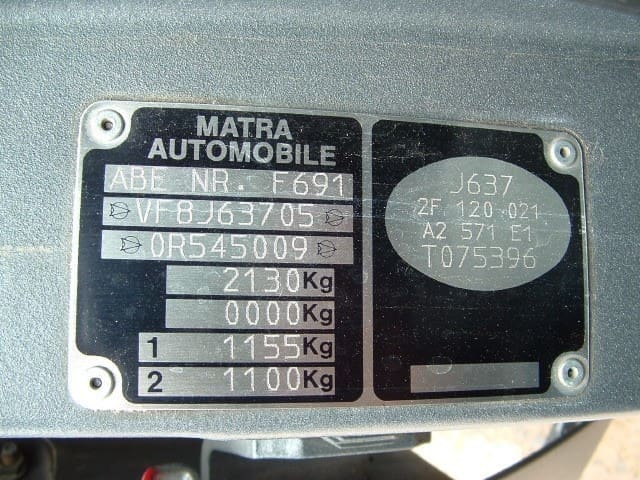
(B-pillar passenger door: Manufacturer: Matra, colour code: 571, Rouge Apache)
But what are you reading this report for? To get information. You can have it: The „unpainted“ parts were painted with the colour
– 8423 Gris Carbone Metallic
and finally with a matt clear lacquer.
The structure of the polyester beads can be imitated perfectly by applying underbody protection. Even a layman can do this well with a spray can.
On the J63, the bumper and roof of the higher-quality models were painted in the vehicle colour, to which polyester beads were also added. The colour difference is only due to this admixture and the altered refraction of light caused by the rough surface. The paint can be applied with a special nozzle on a standard spray gun.
Safety
A rather dark chapter! The Espace J63, which is actually the subject of this article, was built from 1992 to autumn 1996. However, it is based on the 1984 J11, whose frame was taken over almost one-to-one, now considerably stiffened to do its job. The models from the end of 1995 to the end of 1996 were structurally reinforced on the driver’s side after a disastrous ADAC crash test in the front of the car and were fitted with a driver’s airbag and belt tensioners. ABS also became standard from this period onwards. Vehicles with ABS also always have rear disc brakes. The front discs are always internally ventilated.
Due to the high seating position, there is a certain „natural“ side impact protection.
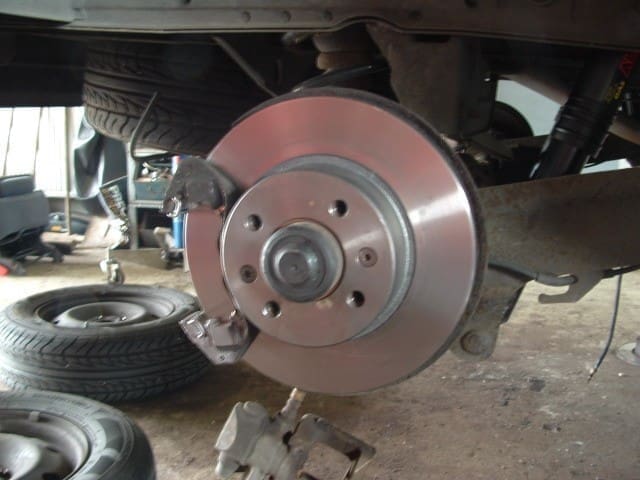
(Rear disc brake, here still without pads)
Crash test results and braking performance certainly do not meet today’s standards, were not particularly exhilarating even in their day. But even today, there are still new vehicles, especially in this class, that do not achieve even these performances.
Hello? I don’t want to drive this thing in front of a bridge abutment! How? Oh yes, that’s right, I already did. But it was fixable and nothing happened. :-/
About the brakes, also called deceleration device: They have about the effect of a drag anchor, just like all Renaults of these years. Have you ever had the „pleasure“ of Twingo brakes of that time? Yes, the Espe also „brakes“ like that. So cruising is the order of the day.
If the car is equipped with rear disc brakes, then sooner or later the right rear brake caliper will hang. Pay attention to this: Puddles always form on the right side of the road. Dirt and stones also collect there far more often. As a result, the right side of the vehicle is used more than the left.
Chassis
J11 and J63 have two superimposed wishbones with coil springs, telescopic shock absorbers and a stabiliser bar on the front axle. The rear axle consists of a semi-rigid, torsionally-formed axle guided by two trailing arms and a Panhard bar. The shock absorbers are installed at an angle.
The J63 is front-wheel drive and it has four wheels, all of which reach the ground. Except for the fifth, which must be dangerous because it’s locked in a cage under the floor of the car. Uh … yeah. :) Sorry, I hate these dry technical data.
The handling is surprisingly agile for a van. Thanks to the very low centre of gravity of the steel chassis and the planked-on GRP panels, cornering is excellent, even if the side slope is relatively large. We remember: every Golf today is heavier. So you can take bends with the Espace correspondingly nimbly.
If the steering, suspension and brakes are in order, the Espace is a pleasure to drive. Everyone who got behind the wheel said that they had not expected a van to be so good to drive. Even die-hard Mercedes drivers were among them.
Comfort
The sound insulation cannot be compared to a current vehicle. Subjectively, however, it is not disturbing either. Up to seven adults can go on city trips on the unfortunately much too small seats. A family with children can travel comfortably across Europe, even with luggage.
Trailer operation
The J637 can tow up to 1,800 kg. It is also possible to increase the load. This is astonishing for the low weight of the vehicle, but it shows the considerable reserves of the chassis. However, the trailer hitch has a correspondingly complex design and numerous struts.
The Espace behaves absolutely calmly with a caravan-sized trailer full of automatics and flippers. We have done this often enough.
The j637 with 2.2-litre farmer’s engine gets the power out of its displacement and easily pulls up any hill. The V6 is, of course, even more powerful.
The JE with two litres, on the other hand, is a disappointment and does not come close to the performance in trailer mode.
Warning!
In general, the trailer should not be too heavy. Bear in mind that ESP was not yet fitted to production vehicles at this time! Even if the Espace is allowed to tow a lot on paper, I would personally do without it! More about this in one of my other articles!
All-wheel drive
Optionally, the almost unbridled power of the four-cylinder is passed on to a carbon-fibre cardan shaft, which drives the rear wheels via a sinfully expensive (if it ever breaks down) viscous clutch.
Automatic
The V6 only fitted in the longer front end of the J63, it was never available in the J11. The V6 was deprived of power distribution to all four wheels for the rest of its life. Whether this was the reason why this machine took out its bad temper on the numerous wrecked automatic gearboxes has not been adequately researched. The only fact is that these transmissions were manufactured by VW in Baunatal near Kassel and were completely overtaxed with the power of the V6. The death of the automatic gearboxes is a common theme in all Espace series. My urgent tip: Hands off!
Engines
All engines up to and including J63 have long since been installed. From JE onwards only transverse engines were used. In Germany the following engines were offered in the J63:
2.2 litre
This four-cylinder engine has 2165 cm³, producing 107 hp (79kW) at 5,000 rpm. At 3,500 rpm, a maximum torque of 170 Nm presses on the crankshaft. The mixture is prepared by an electronic multipoint injection system with knock control. This engine enables a top speed of up to 175 km/h. The 100 mark is reached in 12.7 seconds. These values are excellent for a vehicle with this frontal area and a CW value of 0.34. This is mainly due to the low kerb weight of 1,282 kg (yes, depending on equipment) – any Golf today is considerably heavier. My old Espace, with well over 200,000 km, still has a top speed of 191 km/h – according to the navigation system. :)
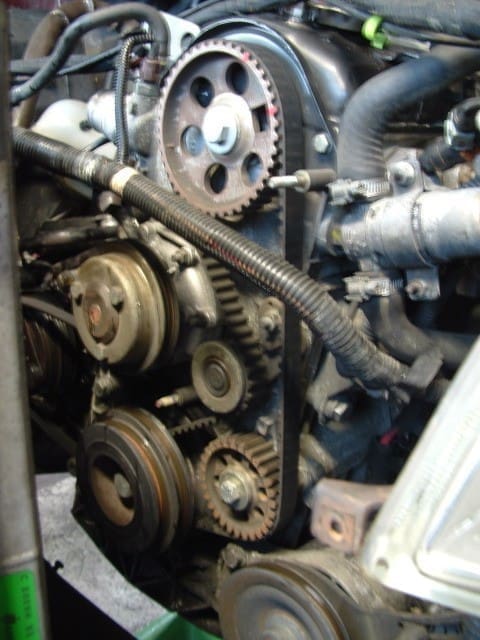
(2.2 litre engine, timing belt)
Consumption is around 7.5 to 11.8 litres. More realistic are 8.5 to 12 litres. With an automatic transmission, these values are significantly higher. The use of air conditioning also has a negative effect on fuel consumption. But that is the case with all vehicles.
2.9 litres
This six-cylinder engine has 2,849 cm³, which produces 150 hp (110 kW) at 5,400 rpm. At 2,500 rpm, 225 Nm are available. The mixture is prepared electronically (Mulitpoint) and with a knock control. This engine makes a top speed of 195 km/h possible. On the way there, at 100 km/h the stopwatch stops at 10.3 seconds. The unladen weight with this engine is 1,348 kg.
Consumption ranges from 8.6 to an absurd 14.8 litres. So a gas system suddenly makes sense, especially when the unreliable automatic is doing duty in this vehicle.
For this engine, there were superchargers from Elia that raised the power to 190 hp. It is relatively easy to push this to over 250 hp with minor modifications. But remember: there is no four-wheel drive for the V6, so the unbridled power only tugs at the front wheels.
Turbo diesel
This four-cylinder diesel engine has 2048 supercharged cubic centimetres. Depending on the model, it delivers between 88 and 90 hp at 4,230 crankshaft revolutions. The maximum torque is 181 or 195 Nm, respectively, and the resulting performance is that of a shifting sand dune in the Western Sahara: the speedometer shows a tranquil 163 to 168 km/h when the accelerator is depressed. The stopwatch shows 14.5 or 15.0 seconds to 100 km/h.
Notional fuel consumption is said to be between 5.9 and 8.8 litres. The diesel was also not available as 4WD.
Addendum: I got this data from the 1994 Renault brochures, but „Espace17“ from the Espcace friends forum insists on these data:
2.068 cc and 4,250 rpm
Well, I’m reproducing this unchecked. He has such a part and if that’s what it says in the certificate, then I don’t want to contradict it.
By the way, he is annoyed by the above-mentioned designation as a shifting sand dune. Rumour has it that he once used it to overtake a Smart for 2 on the motorway.
Electricity
The French and electrics! *sigh*. This unfortunate combination is only topped by „French and electronics„. They just can’t, for whatever reason. Unfortunately, that’s the way it is. And they will probably never learn. If you compare the wiring in an Asian vehicle with that in a French one, even a layman will see clear differences. On the one hand, there are perfectly lengthened cables, each with a predefined position and colour – and on the other hand, cables that are stuffed in wildly and have completely different cable colours from one vehicle to the next. The Espace is no exception. The more modern, the worse!
For us, however, the older the better. But don’t think it’s easy to get to the heater fan in a J63! Or you could easily replace defective switch lights or burnt-out heater fan controls! Anyone who curses about changing headlight bulbs in a modern car will learn pure horror in an Espace! Well… except when changing the headlight bulbs. That’s surprisingly quick. But everything else? Terrible!
Taxes
Save car taxes
The 2.2 litre engine actually complies with Euro2 by default. But when these J637s came on the market, there was no Euro2 emission class yet, so they couldn’t be entered in the papers. There are so-called minicats that help the J637 achieve Euro2 classification. These „catalytic converters“ certainly do not clean the exhaust gases, they are only good for issuing a new type certificate. An exhaust screen would have the same effect, but that would be rather difficult to explain to the customer from a marketing point of view.
The D3 catalytic converters, which are also available, cost many times more and actually clean the exhaust gases somewhat better. However, the tax savings are so small that the extra cost of the minicat is not worth it.
Tuning
Elia offered a supercharger kit for the V6 that increased the power from 150 to 190 hp. Madcom owns one of these, which he brought to just over 260 hp with a mouth-blown, double-flow exhaust system and a little tweaking of the boost pressure. Whether such a power output makes sense when the power can only be brought to the road via the front wheels and is not controlled by electronic aids is open to question. But it is always interesting when your head is pressed energetically against the headrest when you are sitting in a „minibus“.
Even more interesting is that the TÜV was satisfied with the standard brake system.
Interior
Up to seven individual seats in the 2-3-2 division, of which the front ones can be rotated and the rear ones mounted in two notches and in two directions, depending on the equipment. Rearward-facing driving is not permitted. The rear seats of the better or more modern equipment are so-called multifunctional seats: the backrest is continuously adjustable, the headrests are retractable and the seat can be pushed forward and back. The highlight is that the seats can be folded down to form a table. Fold-down trays can be attached to the front seats and armrests are also available as an option for all seats.
The registration document says „up to seven seats“. So if you bought an Espace with five seats, it’s no problem to buy two more.
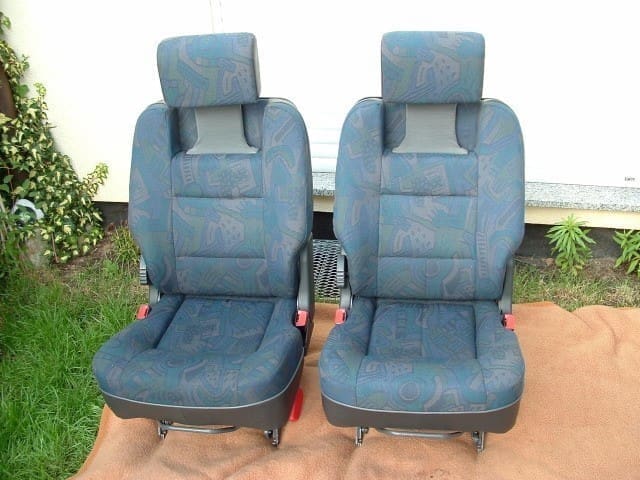
(Multifunctional seats: easy to care for with a shower)
The seats from the JE (without Vario rails) also fit the J63.
The roof can accommodate up to three sunroofs, the front one is optionally electrically operated and can be pushed open. Two different sizes of glass roofs were available. There are reading lamps for all seats except the middle seat and the driver’s seat. Sought-after special accessories are the small parts boxes for the rear storage areas, the luggage compartment cover, the luggage net, the travel cot and the blackout mats for the windows and the sunroofs.
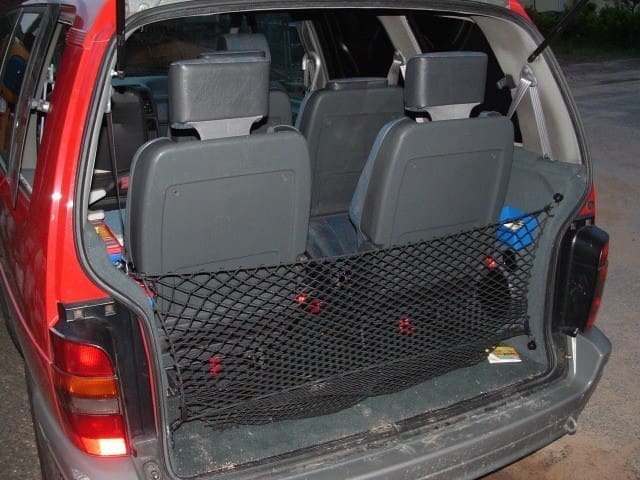
(Luggage net – prevents shopping from falling out when the tailgate is opened)
The air conditioning in the Espace is a really useful extra. The extremely large windows make you think from the end of April that the bath attendant will come in at any moment. Sweaty seats are not only disgusting, concentration suffers considerably when the driver is more busy perspiring than driving.
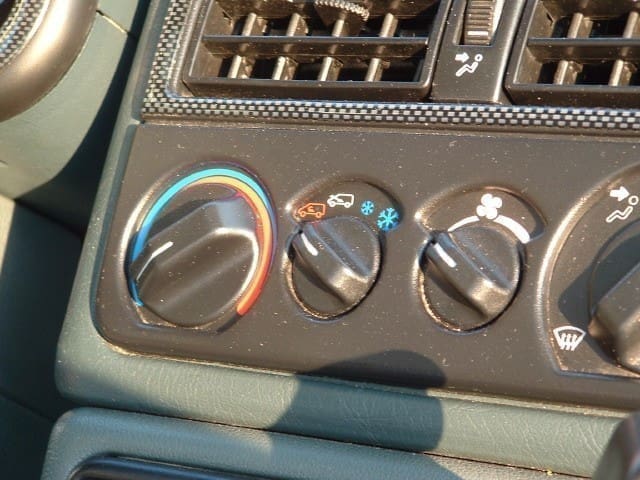
(Air conditioning, second switch from the left)
Even in damp and cold weather, the air-conditioning system ensures a clear view all round within seconds and you can enjoy the sight of wrong-way drivers and crossing deer without annoying fogging.
Spare parts prices
The prices for spare parts are very moderate, as long as it concerns the technology. Any spare parts dealer around the corner can order cheap replacements overnight. It is more difficult – and more expensive – for bodywork and interior parts.
As a general rule, only buy parts on Ebay that are not relevant to safety. Never order suspension joints, brakes and wheel bearings there! Do not buy these parts second-hand! The above-mentioned brake caliper costs just 130,- EUR as an AT part. It is not worth saving money.
Remember: A braking distance that is two metres too long due to a cheap part costs real money in the event of an accident. Not to mention what can happen if it happens to you at a pedestrian crossing.
Checklist
Checklist_J63x (187.49 kB) – here you can download a complete checklist. I have written this list especially for the J63, but I have not checked it against the following. If necessary, please print out the list with copy & paste that follows.
Let’s get down to brass tacks, let’s not beat around the bush, let’s get down to brass tacks and finally clear the decks…. Where was I? Ah, yes, checklist:
Explanations
On the phone
Is it worth the trip? Is it possible to do several visits in one trip?
Is the vehicle really private? Or does it sound like a dealer? For example: „Which vehicle is it?“ – then it is most likely a dealer.
When was the timing belt replaced? Only on diesel or 2.2, the J638 (V6) has a timing chain. Timing belt intervals: 120 tkm OR 5 years!
On site
Engine compartment
How does the engine compartment look? Suspiciously clean or very unkempt?
Is the engine cold? Important to be able to judge the starting behaviour.
Crankshaft seals: if they are too oily, a timing belt and/or clutch change should be planned, as the seals can only be accessed by removing the latter.
Check for head gasket damage: beige, slimy coating in the oil cap or in the expansion tank. Also take a look inside, the covers may have been cleaned. Black crumbs and lumps: oil change intervals not observed.
Which clutch lever was used? Self-adjusting – bad! Adjustable – good.
Do the belts look good or are they frayed?
Do the radiator hoses feel brittle? Are they even inflated? Caution!
Inspection sheet: can be reconciled with mileage?
Are the fans running? They must switch on when the air conditioning is switched on or when the last line before the red area on the temperature display is reached. They are two-stage and are connected in series.
Air conditioning: Leaking?
Outside
More meaningful are paint mist and colour differences.
Do the tyres still look good? DOT number? I have seen cars on the road with tyres that were more than 10 years old!
Same tyres front and rear?
Also check for summer/winter tyres!
Check windscreen for stone chips, otherwise you will have problems with the TÜV.
Check the bumpers for scratches – this allows conclusions to be drawn about the driving skills of the previous owners and the treatment of the vehicle.
Does the central locking work? Do all doors open and close properly?
Is the fuel filler cap rust-free?
Do the exterior mirrors wobble slightly? May be broken on the inside.
With the handbrake on, let the clutch come in to check the handbrake: does the car only dip on one side (usually the left) and does the other stay straight? Brake caliper seized.
Bottom
Springs tend to break at the bottom, is the end edge broken off or cut off?
Rear wheel housings: Rust-free?
Bleed nipples on rear brake callipers (on disc brakes) not broken off?
Tank bracket not completely rusted through?
Catalytic converter not empty?
Oil mist on the underbody?
Brake force regulator: Can it be moved easily by hand? Is it tight? Lines o.k.?
Check side member for deformations: Accident?
Deformations on the cross members behind the front wheel are normal, usually the lifting platform was used there.
Are the suspension joints worn out? The upper ones like to do this.
Inside
Are the carpets in the front footwells damp? This can be caused by blocked drain holes in the ventilation system, but also by a defective heat exchanger in the heating system. Check the smell? Does it smell like coolant?
Headlamp levelling system: usually defective.
Blower: only levels 1 and 4 are functional: Resistors are defective.
Do the pedals, steering wheel and seat upholstery look like they have done the stated mileage?
Check door edges, frame can rust.
Interior headlining loose?
Roof window tight?
Do all seat belt buckles work?
Seat belts not frayed?
Lap belt for centre seat still in place?
Belt tensioners, if fitted, not yet triggered?
Electric windows working?
Does the central locking system work on all doors?
Headlamp levelling system working? (Mostly not)
Do the lights and high beams work? (Light lever defective?)
Smoking vehicle? Check ashtray and lighter. Dirty interior is good reason to knock down price, but can be done with some work.
Check documents
Gives conclusions about previous owners. As already mentioned: It is not the age or the mileage that is decisive, only the care mentality of the previous owners decides whether the car is top or flop!
Do the documents match the age and the stated mileage?
Blender
Tyre colour, rim spray, (new) U-protection, etc.?
Starting
The function of the fans is important. They must start at the last stroke before the red zone!
Are there bubbles in the expansion tank? Movement is normal, real bubbles are not!
Finally
Hot rims show dragging brakes.
Attention!
You will not find a vehicle that has no defects, but you can see from the smilies what predominates. Often you only notice from the list that the vehicle you actually prefer has more expensive defects overall than a vehicle that would have been your second choice.
Assessing the seller
Does he go on and on about how great the car is? Watch out! He wants to distract!
Turn the tables: Pretend to be naive and ask „stupid“ questions. Encourage the salesperson to contradict you. Make small talk, but never give up control of the conversation.
Make a note of the previous owners in the letter and call them (telephone information). Ask about the state of care, reasons for sale, selling price and mileage at the time of sale! They are usually happy to help!
Take your wife with you: She has to complain: The upholstery is stupid, the car is ugly, the colour is dull, something points to an accident. The Sharan is nicer, the other Espace is better, the engine sounds bad.
Beware!
An Espace can turn into a penny diner! Include repair costs in the purchase price!
This also applies to the JE and JK models! Spare parts for these are also very expensive.
In principle, most repairs can be done by yourself with a little skill. The technology is rather robust and easy to maintain. The typical faults are documented in detail on the web – on this page and especially at Espacefreunde – with repair instructions.
With this in mind: Good luck with your Espace purchase and always a dent…. er… that’s right, GRP body… deformation-free journey!
Greetings
Michael
All other articles with and around the Renault Espace.
